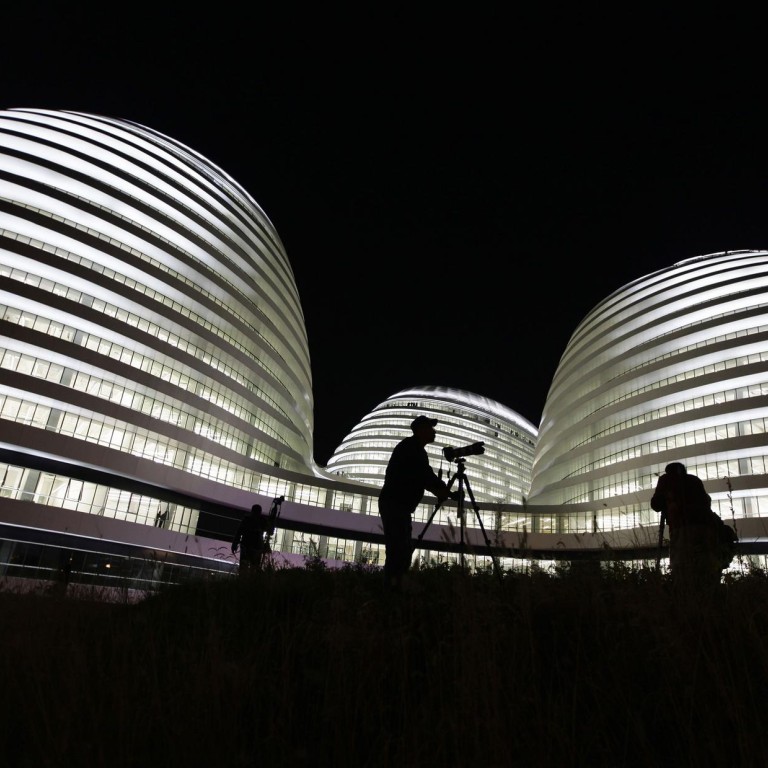
Architecture award to Beijing's futuristic Galaxy Soho slammed by heritage group
Critics say professional body's decision to award Galaxy Soho building is a setback for efforts to preserve vanishing old Beijing
A Beijing heritage group says it's still waiting for the Royal Institute of British Architects to explain why it gave a large, futuristic mall and office complex in the heart of old Beijing one of its most prestigious honours.
The award for architect Zaha Hadid's Galaxy Soho would only make preserving the capital's historic structures more difficult, according to the Beijing Cultural Heritage Protection Centre.
The non-governmental organisation sent an open letter more than one month ago to the institute, protesting its decision to honour the structure.
"We know that the letter reached the institute a while ago, but we have not heard from them yet," said the centre's founder, He Shuzhong.
Completed in October last year, Galaxy Soho is characteristic of the British-Iraqi architect's fondness for swirling, cornerless designs. Four white, domed structures, connected by bridges, rise 15 storeys from the Second Ring Road to form 330,300 square metres of shops and offices. The structures sit on a 50,000 sq ft plot of land, where a decade ago stood a labyrinth of hutongs.
"If Galaxy Soho had been built on the outskirts of Beijing, we would not have had any objections. But it sits on the inner side of the Second Ring Road, within Beijing's protected area. We felt that by doing this, the architects have joined hands with the government and developers in destroying old Beijing," He said.
On June 13, the institute announced that Galaxy Soho was among 12 recipients of its annual International Awards for Architectural Excellence. It praised the structure's "creation of public space" and, as Hadid's first shopping mall, "a welcome democratisation of her work".
"[The building] is distinctly urban rather suburban, civic as much as it is commercial."
He's centre issued an open letter to the institute expressing shock and indignation over the award. "Galaxy Soho is a typical example of the destruction of old Beijing. We are concerned that your institution decided to honour the structure with an award," the letter said.
On July 18, the British institute shortlisted Galaxy Soho as one of three projects in the running for its Lubetkin Prize, given to the best building outside the European Union. The winner will be announced on September 26 in London.
If Hadid is awarded the Lubetkin, it would be the second year in a row that the institute's top award went to a Chinese project. Last year London-based Wilkinson Eyre received the prize for its 440-metre high Guangzhou International Finance Centre. In 2009, Herzog & de Meuron won the prize for its design of the National Stadium, also known as the Bird's Nest, in Beijing.
"In honouring Galaxy Soho with awards, the institute kowtows to the Chinese government and developers, showing little respect for the heritage of Beijing and ignoring our uphill battle in preserving the city," He said.
Over the past two decades, development has led to many old neighborhoods in central Beijing being torn down and cleared.
"The current state of old Beijing is the result of repeated destruction over the years, but this does not give Western architects permission to build such a structure here," He said.
Zhou Rong, associate professor of architecture at Tsinghua University, disagreed.
"Among all the new buildings along the Second Ring Road, Galaxy Soho is a nice structure [that sets] a high bar in architectural design," he said.
Hua Xinmin, who campaigns to preserve Beijing's historic neighbourhoods, said she petitioned the government to stop the demolition of the hutongs. But the courtyards were torn down, and the site, after changing hands several times, went to Soho China in 2005.
The same year the State Council approved a city master plan issued by the Beijing municipal commission of urban planning that laid out guidelines for development through to 2020.
The plan established protection for the entire area within the Second Ring Road. Previous master plans had brought dozens of areas under protection, but this was the first one to do so for the old city as a whole.
"Both the developers and the architects should be aware of the new regulation," Hua said. "Now it looks odd to have such a gigantic and out-of-context structure in the middle of old Beijing."
